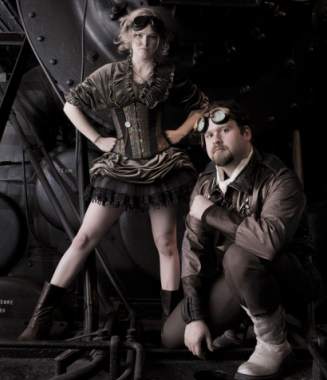“Goths” have long since been defined as a group wearing dark clothes and makeup that worship the punk rock scene and gothic traditions of the 19th century. But watch out goths, there’s a new kid in town: the steampunk.
Steampunk, another subcultural movement that incorporates past, present, and future technology within the confines of the Victorian steam era, is arguably the modern evolution of the 90s goth movement.
Others say no, stating steampunk is its own genre with certain key indicators that set it apart from the Goths.

But which is? Is steampunk an innovative subculture or is it the goth movement of the 90s revisited?
The goth subculture emerged in the 1980s as part of the post-punk goth rock genre. Goths dress in dark clothes and dark makeup, with a culture based mostly of its imagery of 19th century Gothic lit with a splash of horror and a pinch of S&M for good measure.
Steampunk also takes a cue from 19th century literature but rather than Gothic lit, its followers turn to Victorian era works of H.G. Wells and Jules Verne, all while incorporating elements of science fiction and future technology.
Relegated to the steam power of the 19th century, steampunks take future and present technology (like the iPhone) and re-imagine it with moving gears and metal parts.
Dexter Palmer, author of the novel “The Dream of Perpetual Motion,” describes the steampunk label as “Nowadays the label’s much more comprehensive, and seems to refer to any retrofuturistic or counterfactual work that features machines with lots of gears, or lighter-than-air flying craft, or similar sorts of things.”
Although both steampunk and goth draw upon literary imagery, steampunk is a subculture born out of literary creation rather than musical inspiration like goths.
“[Steampunk is] drawing on actual history. You can pull into it what you’re into and put your spin on it. It’s accessible yet expandable,” says Jake von Slatt, whose real name is Sean Slattery of Littleton, Massachusetts.
“There is a real focus on sharing, exploring things together, building community.”
Born from William Gibson and Bruce Sterling’s 1990 novel “The Difference Engine,” steampunks were born as a group devoted to an alternate history about how Victorians would have developed modern gadgets using Industrial age technology like gears and steam power.
Von Slatt argues that steampunk is more than just a way to dress or music to listen to, as he writes on his blog steampunkworkshop.com, “One of the really wonderful things about Steampunk is that it, more than any other subculture, seems to want to teach us things.”
Although Goths also give followers a different way to look at the world, steampunk enthusiasts add their vision is more about empowerment and optimism, “We also embrace and foster good manners and dressing up, which are both sorely lacking in society today,” says Diana Vick, vice chair of Steamcon, an annual steampunk convention in Seattle.
Probably the main difference between the two genres is the openness of the steampunk culture and the closed, sometimes scary culture of the goths, at least from an outside perspective. Tom Sepe, an artist and steampunk fan says that unlike other subcultures, “It doesn’t take itself too seriously.”
People seem to latch on to a particular culture based on how it allows them to re-envision their world. Both goth and steampunk subcultures offer an alternative view, but the former acts as a celebration of the past and future, while the latter acts as somewhat of a rejection of modern society.






